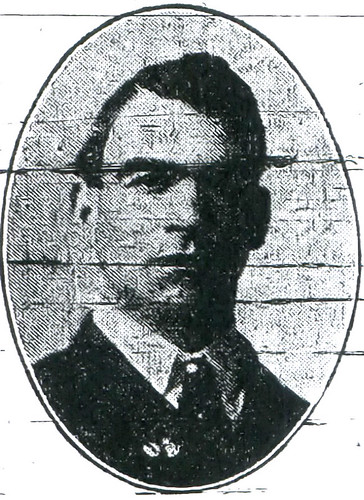On a May day in 1910, Joplin nearly lost a councilman. Jesse Laster, not a stranger to the zinc and lead fields of Southwest Missouri, listed zinc mining as his profession in the 1910 Federal Census. It was that same year that Laster had been elected on the Democratic ticket to represent the Seventh Ward of Joplin. A father to three, later to add one more son to the son and two daughters he already had, Laster had ventured out with a mine superintendent, Harry Williams, to a mine in Duenweg.
The afternoon sun high above, the 28 year old councilman and Williams made the decision to board a tub to descend to the mine 200 feet below. Both had years of mining experience and undoubtedly the act of being lowered in the metal container into the dark depths of the mine shaft was a familiar one. Inside the tub, one or both of the men likely signaled the mine’s hoisterman to lower them down.
The hoisterman was new at his job and the equipment purported to be in good shape. However, as the tub with the councilman and the superintendent began to lower, the hoisterman released the brake and to his horror, watched the tub with the two men plummet to the bottom of the shaft. Nothing the hoisterman did slowed or stopped the tumbling tub. In a sickening sight and loud crash, it smashed into a bucket full of dirt. Laster and Williams were thrown out and into an adjacent drift, both men knocked unconscious.
It was not uncommon for miners to die in such accidents, but both Laster and Williams survived that day. When astonished and fearful miners reached the men, they found Williams with severe wounds to the head and a broken arm. The councilman suffered a cut to the face, an injured shoulder, and a broken right femur. Williams was taken to his home to recover, Laster was rushed to St. John’s hospital. At the time of the reporting of the incident, it was believed both men would recover. Laster did, though only to live for another sixteen years.
The dark eyed and dark haired councilman, perhaps wary of the mining profession, had by 1918 joined the Joplin Police force and achieved the rank of detective. By 1926, Laster had been promoted and wore the title Chief of Detectives. On a hot August evening, the chief with his family were heading home when Laster spotted an armed man by the side of the road. Unknown to the former councilman, the man was engaged in bootlegging and mistakenly believed Laster and his family to be rival bootleggers. When Laster identified himself, the man shot and killed the 46 year old father of four. Laster was the tenth Joplin police officer to fall in the line of duty.
Sources: 1910 Federal Census, 1920 Federal Census, Joplin Police Department website, and Joplin Daily Globe.

